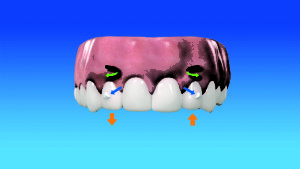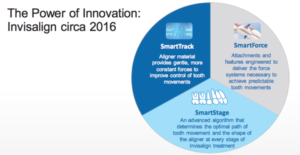Invisalign–the latest developments
Invisalign just released the latest version of their appliance, known as G7. The engineers at Invisalign constantly work to improve treatment outcomes and predictability through computer modeling and listening to the feedback of orthodontists in the field. The latest version focuses on three important improvements:

Enhanced control of upper lateral incisors via new attachments.
- Better control of upper lateral incisors, which are the second from the middle. These teeth are notorious for being the most difficult to control. The new version of Invisalign features improved lateral incisor attachments; those small, tooth-colored shapes that are bonded to the teeth during treatment.
- Better control of roots. This has also been accomplished with newly improved attachment design.
- Prevention of heavy bite contacts on the front teeth through optimally positioning the front teeth.
What does this mean for patients?
There are two holy grails in orthodontics: quality results and shorter treatment times. The more control we can get of tooth movement, the better the outcomes will be in the shortest possible time. Lately there has been much focus on faster treatment times, with various methods of achieving them by supposedly affecting the physiology of our jaw bones. Some of these methods lack scientific proof of effectiveness. Any successful measures that make tooth movement more predictable will reduce the need for additional refinements, which can potentially save months of treatment.

But that’s not all! Invisalign just made a very significant recommendation
Depending upon the situation, aligners are typically changed every 10-14 days. They’ve determined that tooth movement is just as successful for most patients when the aligners are changed every 7 days. This potentially cuts treatment time in half! This will not be the case for all patients, and the orthodontist must monitor each patient’s progress closely and verify that the 7-day interval is working for them.
The importance of selecting the right Invisalign doctor:
Successful outcomes in the shortest time depend only in part on the particulars of the aligner system. When your case is submitted to Invisalign, an initial treatment version is created. The orthodontist must then alter the plan to meet treatment objectives and to optimize treatment predictability & efficiency. This includes factors such a placement of attachments, optimizing how tooth movement is sequenced, potential use of elastics and reshaping of teeth, and sometimes using a mixture of aligners and limited braces. Knowledge and skill in modifying the treatment plan comes with experience, attention to detail, and advanced training. Getting certified in Invisalign treatment is easy. Becoming adept at designing and applying Invisalign treatment is not. Therefore, please do your homework and select an experienced Invisalign orthodontist who is dedicated to continuing education. If you have any questions regarding Invisalign treatment, please feel free to contact me or post the questions here.


